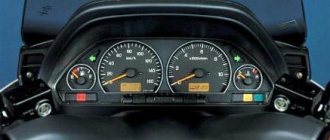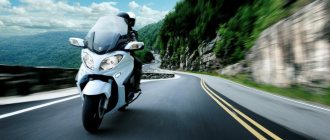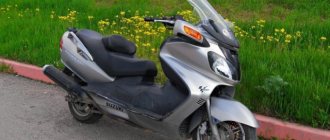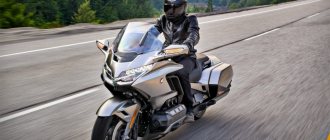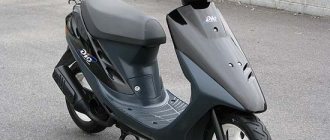Shine of silver (review of the Honda Silver Wing 600 maxi-scooter)
Switching to a maxi-scooter after ten years of riding “full-fledged” motorcycles is a responsible act. It’s like a city dweller moving to a village, getting a hairy haircut “like Russia” and “starting from scratch on Monday.”
Honda Silver Wing 600, maxi-scooter Year of manufacture 200Z Engine 582 cm3 Max. power 50 hp Weight 223 kg The price of the tested scooter is 173,000 rubles.
Back on the scooter!
I would never have thought that you could ride a scooter as fast as a motorcycle, and moreover, with comfort. And my friends: “Oh, you’re starting to get old…”, “It would be better for the same money to take a used 600!”... This is because they judge speculatively. But you need to “ride” a maxi-scooter to appreciate its advantages.
I went and compared. A sportbike is a provocateur, the word “evil” stuck to it for good reason. And then, he is a voracious gas guzzler. No matter how hard I tried to ride it “for pleasure,” I couldn’t get it. For me, driving something in between, and therefore the best, that exists between the clumsy “tourists” and compact “sports”.
One day, while “wandering” on the Internet, I came across an uncle’s diary, who sorted out the reasons for his decision to replace the 1800 cc Honda Gold Wing with the 600 cc Silver Wing. I was intrigued: what he presented turned out to be close to me. Having changed to a “silver”, the uncle, continuing to travel with his comrades, recorded mileage, fuel consumption, other costs... And described the thrill. Summarized: after a month of daily trips on the Silver Wing 600, a scooter with a CVT, with a seat “like on a stool” and a “plush” character, in his words, I absolutely did not want to return to the saddle of the venerable “Golda”... I believed what I read - and bought Silver Wing .
What is a buzz? This is what I discovered about the scooter's potential. But for this I had to drive it almost 3000 km.
The in-line two-cylinder 582 cc engine with the PGM-FI electronic injection system never failed . It starts easily - from the first touch of the starter button, it runs smoothly, no extraneous noise. Two balancer shafts dampen all vibrations... Honda engineers have created an engine that is “not seen or heard.” However, this is an image. And if we talk about the real thing, the exhaust here is smooth, quiet bass.
I can’t imagine that driving a Silver will remain comfortable if the exhaust is equipped with a direct-flow muffler: they are incompatible! And I’ll add: the exhaust system is equipped with a catalyst, so the scooter meets the requirements of the Euro 3 standard.
After 16,000 km, I took it to a branded technical center for diagnostics. I was waiting for everything. However, the experts reassured us: the engine is like new, the valves do not need adjustment, the injector is clean, like a child’s soul, and synchronized. The experts gave important advice: do not lose the small black key to the anti-vandal lock - it is unique! You can only get a copy... with a new lock. I checked: you can close the lock with any hex key, but only “relatives” can open it.
Comfort vs reality
I had the opportunity to drive Silver cars of various years of production - from 2001 to 2007. There are no significant differences between them. The only thing that distinguishes those produced before 2003 is the absence of ABS. But even among the models of recent years coming from Japan, there are samples without an anti-lock braking system. But those that were supplied to the USA and Canada, and since 2003 to Europe, were supplied only with ABS.
The combined braking system is the chic feature of this maxi-scooter. If you press the left lever, both circuits are activated simultaneously, on the front and rear wheels. The forces on the brake discs are distributed approximately evenly: 60% on the front and 40% on the rear. The factory-set braking dynamics are sufficient to stop the 220 kg Silver Wing exactly where you want it to stop. But even without ABS, I only managed to skid the rear wheel a couple of times, and then only on slippery markings after the rain. All thanks to the large wheelbase -1590 mm and the location of the engine in the body of the device (it is lowered as far as possible and shifted towards the rear wheel).
The right lever controls only the forward circuit. If you press both at the same time, the brakes will bring the scooter down so abruptly that an unprepared pilot will be thrown from the “sofa” onto the dashboard. A “chopper” landing will help you avoid falling forward - this is when your legs are extended forward, with your feet resting on the stance (the manufacturer has prudently extended the rubber mats to the middle of its height). This way, chopper-style, it’s more convenient than simply placing your feet on wide platforms on both sides of the tunnel: sharp shocks back and forth during acceleration and braking are absorbed and are not annoying. And if you want to change your position, just move your feet to the platform - and you’re a traditional scooter rider again! And to complete the description of the seating position: the back of the driver's seat is also adjustable - it can be moved back and forth.
The instrument panel is simple and clear, with information on everything you need to know before, during and after a trip : tachometer, parking brake indicators, oil pressure indicators, CVT belt wear indicator, large yellow turn signal indicators and, finally, an easy-to-read dial speedometer in the center of the panel. The right side of the dashboard is the most valuable source of information. Here, fuel level, engine temperature, and mileage are displayed on one screen. There is also a clock here. The digital odometer has three independent memory cells: two temporary ones - with turning on and resetting the mileage counter and one - with the total mileage counter.
The centrifugal clutch “seizes” at approximately 1800 rpm. It’s not easy to “catch” constant thrust “from scratch” around 2000 rpm. The “uncertain” behavior of the Silver Wing at speeds up to 10 km/h will take some getting used to. The reason for this is not the speed, but the excessively soft suspension, especially the fork. At speeds above 20 km/h, the only thing that can affect the straightness of the ride is deep ruts in the asphalt. This weakness of the “silver” will be felt more acutely than others by those who switched to it from a motorcycle with its wide 17-inch wheels: those on this scooter (front - 14 inches, rear - 13) seem too small. And I advise you: it’s not worth experimenting with jumping onto longitudinal sections of asphalt. Regarding wheels for the practical rider, I’ll add: buying tires for the Silver Wing is easy, they are in stores.
V-MATIC: three gears as one
A traffic police inspector once stopped me to check my documents, and started asking: “Isn’t it scary on him?” - “Very scary, in first gear the acceleration is up to 160...” His eyes are wide open! I looked at the speedometer, and there was a marking on it up to 200 km/h. “And then how long will the second one be?!...” - “I don’t know, I haven’t tried it yet!”
I didn’t lie very much, but in the main, in essence, no. On the streets of the city, “silver” is king. I didn’t measure how many seconds it takes it to accelerate to “hundreds,” but up to 80 km/h it is capable of “making” any mass-produced car from a traffic light. Then the acceleration is no longer so bad. Honda has developed a very user-friendly “nearly continuously variable” V-Matic transmission. It seems that there is only one program, and it is for all occasions. The V-Matic actually has three modes: "city", "touring" and "full power". The engine control unit is connected directly to the gearbox and, depending on the driving mode, it calculates the quantity and quality of the mixture to be supplied to the combustion chamber. What this gives is illustrated by the numbers. On the highway, when the scooter travels for a long time at a constant speed (far from 80 km/h), consumption drops to 4.5 liters. In the city, where you often accelerate, unscrew the handle all the way, and then also sharply brake to zero, it increases to 6.5.
Slowly does not mean slow
The advantage of the Silver Wing 600 over 400 cc and 250 cc scooters of similar dimensions is the ability to comfortably (this is important) move at, mind you, 140 km/h . For a “silver”, this speed is cruising, at which the scooter does not strain or strain at all.
High glass provides excellent protection from wind blowing at any speed. Unfortunately, this grace does not extend to the passenger: the “second number” sits about 10 centimeters above the driver, and the entire flow of incoming air enters his helmet. Fighting the wind is tiring. Based on the results of the analysis, after several “non-stop flights”, the Formula of Absolute Comfort was derived (it is not necessary to create an abbreviation from the first letters) for the full crew: this is when the pilot, upon reaching a certain speed, is no longer bored, and the passenger is not yet blown away. So, if it’s just two of you, then you need to move at a pace of 120-130 kilometers per hour on the highway, and in city traffic - about 80 (if possible).
The Silver Wing 600 tank is spacious, 16 liters, and its contents are designed to last approximately 400 kilometers. This is ideal as described in the instructions for use. But the maximum I managed to achieve when driving “our” AI-95 was 300 kilometers. It’s a shame: every time they “break off” a hundred miles from what was promised.
A couple of years ago I had to urgently go to St. Petersburg on business (and therefore under my own power) on a heavy sports motorcycle. “Taking a quick flight” on an airplane would be much easier and, considering the collected package of receipts for paying fines for speeding, cheaper... After such trips, you understand why large touring motorcycles and even scooters such as the Silver Wing were invented. The recent trip on the Silver to St. Petersburg and back was like an easy country walk, and it took only half an hour more time than on the Sport two years ago. The explanation is simple: fewer stops along the way - higher average speed. If on a sportbike I had to stop three times to refuel and one more time just to stretch my stiff back and shoulders, then on the “silver” there were only two short pauses in riding. And there was no need to pay for exceeding the speed limit.
What does the new owner of Silver need to do?
The first thing is to equip xenon low beams - to improve your visibility in the dark, and so that the scooter becomes truly noticeable to car drivers. The operation takes no more than half an hour and requires virtually no electrical intervention. The huge headlight consists of two parts - low and high beam reflectors, containing H7 type lamps. It is most convenient to “settle” the control unit in the right “pocket” of the glove compartment. From here to the headlight in a straight line is no more than 20 centimeters, so there will be no difficulties with laying the wires.
Secondly, the program for preparing the scooter for everyday use should include light tuning of the fork. It is necessary to replace the oil in it with a thicker one, for example, with a viscosity of 15W, the “plushness” in the character of the maxi-scooter will decrease, and the handling will increase.
Third. Don’t be fooled by the volume of the trunk because it is intricately shaped; the 55-liter capacity can accommodate a helmet, a wheel lock, a raincoat or cover, a pair of gloves and, in fact, that’s all... So, I highly recommend installing additional panniers. Find them for the Silver Wing, complete with mounting platforms, in the catalogs of companies producing tourism accessories. The 40-liter, with a platform, is also included in the line of original Honda accessories.
Silver Wing – for the practical
After a year of riding this scooter, I have never regretted buying it. Nonda has embodied its traditions of meticulous attention to detail in this “maxi” - from design to details. What will appeal to those who are not inclined to hang around in the garage for minor repairs. Personally, I liked it: I managed to clock up 8,000 km on the odometer on a variety of roads, even on dirt roads near Moscow, and there wasn’t a single mechanical breakdown or malfunction of the electronics or engine. I only went to the service center once, but for a preventive, seasonal change of oil, filters and spark plugs. Installing xenon and changing the oil in the fork does not count: I was experimenting.
Technical characteristics and photos of Honda Silver Wing 600
Test drive Honda Silver Wing 600, Suzuki Burgman 650
The information presented in this article is based not on a momentary acquaintance with both maxiscooters (called “sofas”) and their technical characteristics, as is often the case during tests, but on long-term experience in operating each of them. Having driven more than 16 thousand kilometers on the 2003 AN 650 SkyWave (the Japanese name for Burgman) over the past season, I was able to test it in almost all kinds of conditions. We covered highways, Crimean serpentines, off-road roads and, of course, thousands of kilometers through our beloved Kyiv - the city of chestnuts and traffic jams. But, unexpectedly for myself, when choosing a two-wheeled friend for the new 2007 season, my choice fell on the Honda SilverWing 600. At the time of writing this review, the SilverWing had already traveled with me about 10 thousand kilometers. There is quite a lot of information to write this article, so I will try to outline everything that may be useful to you when choosing between these two beauties.
The differences between both scooters made themselves felt immediately after purchasing the SilverWing 600. The first ones were sharply negative. One of the minuses of Silver is the mirrors. Burgman's are definitely better, both in size and location. Another is the feeling of lack of dynamics when accelerating the Honda. But, 20 minutes after the first running kilometers, clear advantages were revealed. The tall Givi windshield installed on the device I received was definitely an advantage in comparison with the “narrow” one, which was too short and did not protect enough from the headwind. The passenger especially felt this. It was also impossible not to note the absolute comfort of the Honda when driving over bumps and light potholes on the roads, where the Susa’s suspension gave up and sometimes went all the way.
After a month (after getting used to the device), the positive aspects began to arrive, and I decided on the first experiment - I replaced the stock variator with a Malossi Multivar 2000 (costing about 200 euros). This miracle of Italian engineering includes the CVT itself and two sets of rollers weighing 21 and 24 grams (while standard Honda rollers weigh 28 grams each). After experimenting, I decided to install rollers from both sets mixed - one 21 grams, one 24 grams. As one would expect, the intensity of acceleration to 100 km/h increased noticeably, and I got what I was sorely missing. Moreover, in occasional competitions with the AN650 on the road, it was always possible to immediately leave them behind with a gradual increase in the lead. But this is provided that the Burgman was driving in normal mode, without the magic “Power” button turned on. When this button is turned on, the Suzuki becomes noticeably faster...
In appearance, the Burgman is still a “ponto-launcher”, and it looks decidedly better due to the side lights placed on the front of the rear-view mirrors. But the Honda from the front looks no worse. From this perspective, it is a pure sportbike, with the shape of the headlight most reminiscent of the “sport” Suzuki GSX-R.
Having conducted a cross-sectional survey among the motorcycle and non-motorcycle public, I also realized that opinions on “who looks better” are divided approximately in half, so, as they say, “it depends on taste and color...”.
The Suzuki weighs more, but feels much more. I considered this factor an advantage for myself, because I really like this heaviness in my hands. But I heard the opposite from some Burgman drivers...
The engine design of both scooters is admirable, especially the “combine” design of the AN650. But I probably wouldn’t disassemble it in the field in case of an unexpected breakdown, and that says it all. In addition, materials on the Internet found in various sources, and the experience of a real “overhaul” of more than 20 models of each of these devices indicate that various “sores” of the engine or transmission in Suzuki were detected much more often.
After inspecting the Honda's CVT compartment at 10,000 km, I was surprised to discover that the belt, clutch and CVT were in almost perfect condition, which, however, I attributed to the neatness or cowardice of the previous Japanese owner.
Both engines are two-cylinder, water-cooled. Suzukovsky, however, works noticeably louder. Honda's transmission drive is CVT, while Suzuki's is automatic or semi-automatic (5-speed gearbox that automatically shifts up or down if the crankshaft speed approaches extreme values).
Turning on the Burgman's "Power" button is only possible in automatic gear shift mode. This is a very convenient solution that I used when I needed to make an operational maneuver, especially in the hustle and bustle of city traffic. The principle of its operation: the engine control unit will keep the speed in the zone close to maximum power and change gears accordingly. Gasoline consumption undoubtedly increases, but the result of driving with the option enabled is impressive. A similar button appeared on the 600th Silver Wing, starting with the 2006 model, but I have not yet had the opportunity to test it.
From many acquaintances of “Hondovods” we have heard about an incomprehensible “failure” at a speed of 80-90 km/h, when, with the gas handle turned off, the scooter seems to “choke” until it passes the mark of 105-110 km/h. But, as mentioned above, with the installation of the Malossi variator on the Honda, I forgot about the advantages of the Suzuki in acceleration and dynamics.
When it comes to suspension performance, Honda is the undisputed leader. Firstly, high ground clearance and a larger tire tread give the Silver undeniable advantages in uneven conditions on our roads. Secondly, on the same pits with similar hard shock absorber settings and equally serviceable forks, the Honda does not throw so much, and it turned out to be much easier to get out of the unexpected “sausage” obtained in this way. In addition, there is an opinion about the short life span of Burgman wheel bearings. Agree, this is also an important factor, especially after reading the complaints to Suzuki service centers in Europe, where some devices had their bearings replaced after the first 5 thousand kilometers! By the way, when installing Michelin Pilot Sport tires on the Burgman, cornering it into incredibly sharp corners becomes quite easy. Although I must note that Honda behaves no worse with standard Danlop.
There are no complaints about the brakes. Both scooters showed excellent braking results. Moreover, they are approximately the same, despite the fact that Honda has one brake disc at the front and rear, and Suzuki has one more at the front.
During the first kilometers, the Honda got the impression that it was “eating” more gasoline. But, as measurements showed, it was only the last strip of the fuel level scale in the tank blinking too early. Watching this blinking, I managed to drive more than 30 km to a gas station. In general, with skillful control of the Honda at various speeds, the consumption is absolutely identical to that of the Suzuki, although the advantages of the gearbox cannot but be attributed to the “pluses” of the AN650. Another observation: Honda turned out to be less demanding of domestic gasoline, and agrees to “eat” almost any 95-octane gasoline, while in order to achieve optimal performance, the Burgman had to fill it with “95+ premium”, and Shell gas stations ", "TNK" and "Lukoil" were experimentally rejected (based on dynamic characteristics and the amount of subsequent kilometers traveled before the next refueling).
It is definitely difficult to maneuver around the city with its numerous traffic jams on both scooters with their dimensions. The minimum speed at which it is possible not to drop the devices is a little more than 5 km/h. Windage in crosswinds is large for both devices, but due to the greater weight, the AN650 “rearranges” less, and, in my opinion, the weight in such conditions adds a little comfort. But, if the wind still “overwhelms” the scooter, then, unlike Honda, Suzuki has much less chance of returning to a vertical position.
The actual maximum speed of the AN650 is 10 km/h higher, but the comfortable cruising speed of both devices is the same - 140-165 km/h. And only on extremely smooth autobahns in windless weather can you experience what these “monsters” are capable of with the throttle cranked to the maximum.
It is difficult to name an undisputed leader in ergonomics. In terms of visibility, the Burgman wins. Its mirrors can be called an ingenious design solution, both in size, design, and location - in the same plane as the dashboard. This is very convenient: you don’t have to switch your peripheral vision between the instrument panel and the mirrors, as is the case with the Honda. I have to admit that on the Honda I began to look in the mirrors less often and turn around more often. In addition, in addition to the insufficient area, the Silver Wing mirrors have another drawback - they vibrate, but this was cured by installing heavier steering dampers.
The Suzuki dashboard, with the exception of the not very readable tachometer, did not cause any complaints - everything is very informative, readable and convenient. Honda designers lost slightly in this regard.
Silver's high windshield allows the driver and passenger to feel as comfortable as possible, especially in comparison with the Burgman's passenger seat, where comfort is hampered by the turbulence of the air flow, which even at a speed of about 120 km/h does not cause the most pleasant sensations. Even “in the state”, the “Silver” windshield is higher than that of the Burgman 2003 model year, but Suzuki designers have already equipped newer models with height-adjustable glass.
In both cases, the seats of the compared models, which can rightfully be called sofas, are truly royal. The comfort of placement, leg positioning and seating for both driver and passenger is at the highest level. The luggage compartment is quite spacious on both scooters, although the Susa has more. The location of the battery and access to the side lamp compartments in the Honda certainly pleased me.
And one more important factor: if you are taller than 185 cm, I do not recommend choosing a Suzuki - with my similar height, I almost rested my knees on the front panel. On the Honda there is enough reserve for any position of the legs. Moving on both scooters off-road or in sand is a disaster. When overcoming the very first 3 meters of dry sand, both devices were successfully bogged down. After which they were just as successfully pulled out with the help of three pairs of strong male hands. When overcoming obstacles in the form of wet primer or the same sand, each of the devices is worthy of a three-point mark. At the same time, in first gear in semi-automatic mode, Suzuki was a little more confident, despite the greater weight. Honda is able to overcome hilly terrain and small hills much more easily (due to the higher profile of the tires and greater ground clearance). Of course, I don’t regret switching to Honda. Firstly, another device is a huge plus to the experience. Secondly, “Silver” is a victory over the traps of Ukravtodor. Thirdly, the Honda seems to me more convenient and even easier to maintain, especially in the event of forced repairs in the field. For the near future, if the market does not provide an opportunity to switch to some interesting new product, I will focus on purchasing a 2006 Honda Silver Wing 600. To the question that I was asked very often: “Which one is better?”, I still answer: “They are different, I advise you to definitely try both.” Although in fact, I am more pleased with the Honda in domestic operating conditions.
Text: Andrey Shmyndyuk (GRUZ), MotoUA.net expert
Photo: author



